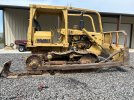The stars aligned today and I had assembled everything I though I'd need to do that final drive bearing adjustment. So, I went ahead and executed the procedure as outlined in the manual to adjust the bearings. I went with the separate the track option and I think it went OK. Took me most of the day, though.
I broke the track at the rear (took this idea from RC, thank you), then pulled the tractor forward a bit to give myself room to work and jacked up the right rear to get the sprocket clear of track. I was able to remove the dust cover and the lock and the slotted nut loosened easily (no cheater needed). Next I tried to tighten the smaller nut at the end of the shaft (smaller = 2 3/16" socket). I was not able to tighten that nut at all. My cheap harbor freight 1" breaker bar now has a permanent bend. Anyway, then I tightened the big slotted nut with my new spanner wrench and a cheater pipe to approximately the torque value specified. It felt fairly tight at that point and definitely tighter than as found. As per procedure I then turned the nut a further 3" plus a bit to allow the lock to reinstall. At that point I feel it was quite tight and certainly tighter than the 350 ft-# spec'd in the procedure.
Next task was to put the track back together and that took a few minutes. I backed the tractor up to the starting position and used a farm tractor to pull the top of the track back to a position where I could almost put the master link back together. At that point I had to detach the chain in order to get it out of my way. Before that, however, I used a couple of 2" ratchet straps to pull the track together on the bottom side so my way was clear to install the track pad and bolts into the master link. It wasn't a terrible job. The ratchet straps that I used have a bent plate at the ends that will just barely fit between the track pads and I put one on either side of the rails. With that, a couple of taps with a hammer got the master link all aligned and the rest was easy.
I don't know yet whether this will have any effect on my final drive leak, but I expect to know soon. Not decided yet whether I want to do the other side now.
Oh, one more thing...I did this as a one man job, but it would have been nice to have someone to watch for me while I moved dozer and farm tractor. Otherwise, I managed just fine without assistance.

